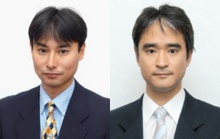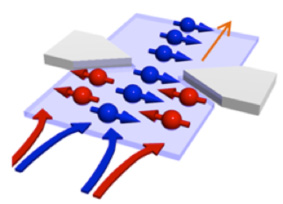Prof Ono, T., et. al. “Realization of the Electronic Stern-Gerlach Spin Separation in Nano-device” (Published in “Nature Communications” 25 September 2012)
|
Realization of the Electronic Stern-Gerlach Spin Separation in Nano-device
Published in “Nature Communications“(Online Publication, September 25, 2012).
Assoc Prof Kobayashi, K. (presently, Prof in Osaka University), (Nanospintronics, Division of Materials Chemistry ) |

Prof ONO, T, |
||
| Makoto Kohda1, 2, Shuji Nakamura3, Yoshitaka Nishihara3, Kensuke Kobayashi3,4, Teruo Ono3, Jun-ichiro Ohe5, Yasuhiro Tokura6, 7, Taiki Mineno1, Junsaku Nitta1
1 Department of Materials Science, Tohoku University |
|||
| The demonstration of quantized spin splitting by Stern and Gerlach is one of the most important experiments in modern physics. Their discovery was the precursor of recent developments in spin-based technologies. Although electrical spin separation of charged particles is fundamental in spintronics, in non-uniform magnetic fields, it has been difficult to separate the spin states of charged particles due to the Lorentz force, as well as the insufficient and uncontrollable field gradients. We demonstrate electronic spin separation in a semiconductor nanostructure. To avoid the Lorentz force, which is inevitably induced when an external magnetic field is applied, we utilized the effective non-uniform magnetic field, which originates from the Rashba spin-orbit interaction in an InGaAs-based heterostructure. Using a Stern-Gerlach-inspired mechanism, together with a quantum point contact, we obtained field gradients of 108 T/m resulting in a highly polarized spin current. | |||

Figure 1. Stern–Gerlach type spin separation in a quantum point contact. |
|||
| This work was partially supported by the Collaborative Research Program of Institute for Chemical Research, Kyoto University, by Grant-in-Aids from Japan Society for the Promotion of Science, and by JSPS Funding Program for Next Generation World-Leading Researchers. | |||
 Institute for Chemical Research, Kyoto University
Institute for Chemical Research, Kyoto University International Joint Usage Research Center
International Joint Usage Research Center